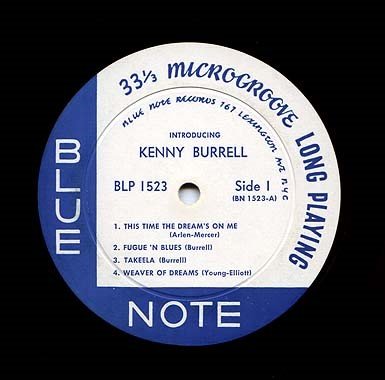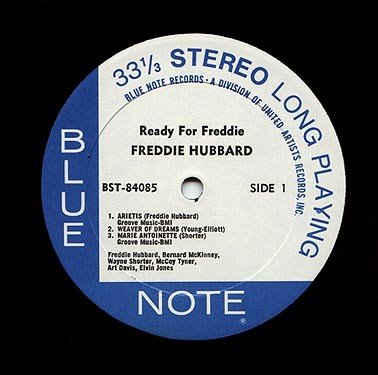เลเบลแผ่นเสียง Blue Note ต่างๆ
เลเบลที่ 1

เลเบลนี้ใช้ในช่วงแนะนำแผ่นเสียง Blue Note ในปี 1951 ถึง 1957 สีพื้นเกือบทั้งหมดจะเป็นสีขาว เฉพาะด้านซ้ายมือขนาด 1 ใน 6 ส่วนของฉลากจะมีสีน้ำเงินปานกลาง และมีตัวพิมพ์สีขาวคำว่า BLUE อยู่ในแนวตั้ง และคำว่า NOTE ในแนวนอน นอกเหนือจากนี้ตัวพิมพ์จะเป็นสีน้ำเงิน มีข้อความ 33 1/3 MICROGROOVE LONG PLAYING พิมพ์อยู่ที่ขอบฉลากตามโค้งจาก 11 นาฬิกา ถึง 4 นาฬิกา
ส่วนข้อความ BLUE NOTE RECORDS 767 LEXINGTON AVE NYC พิมพ์อยู่ในตำแหน่ง 3/4 นิ้วจากขอบฉลากตามโค้งเช่นกัน เลเบลรุ่นแรกนี้จะเป็นแผ่นค่อนข้างแข็งและหนัก ส่วนรุ่นหลังจากนี้จะเบากว่าและงอได้บ้างเล็กน้อย
อัลบั้มที่ออกมาในช่วงระหว่างนี้ เช่น :
Sidney Bechet. Blue Note Jazzmen with Wild Bill Davison. Sidney Bechet, soprano saxophone. Wild Bill Davison, cornet. Jimmy Archey or Ray Diehl, tuba. Art Hodes or Joe Sullivan, piano. George “Pops” Foster or Walter Page, bass. “Slick” Jones, drums. Blue Note BLP 7001 10″ (1951).
Bud Powell. Trio. Bud Powell, piano. Curley Russell, bass. Max Roach, drums. Blue Note BLP 1503 12″ (1951).
เลเบลที่ 2

เลเบลนี้เริ่มใช้ในปี 1958 จนถึง 1962 คล้ายกับเลเบลแรก แต่ต่างกันที่ข้อความที่อยู่บนเลเบลเปลี่ยนเป็น BLUE NOTE RECORDS · 47 WEST 63rd · NYC ระหัสเลขที่แผ่นมีทั้งนำหน้าด้วย BLP น่าจะมาจากคำว่า Blue Note LP หรือ BST น่าจะมาจากคำว่า Blue Note stereoใน issue หลังๆจะพบคำว่า INC เพิ่มอยู่หลังคำว่า RECORDS การบันทึกในแผ่นเลเบลนี้มีทั้ง monaural และ stereo
หนึ่งอัลบั้มในยุคเลเบลนี้ คือ :
John Coltrane. Blue Train. John Coltrane, tenor saxophone. Kenny Drew, piano. Paul Chamber, bass. Philly Joe Jones, drums. Dr. Rudy van Gelder, recording engineer. Blue Note BLP/BST (8)1577 (1958).
เลเบลที่ 3

เลเบลนี้ใช้ตั้งแต่ปี 1962 ถึง 1966 สังเกตที่คำว่า 33 1/3MICROGROOVE LONG PLAYING พิมพ์อยู่ตรงขอบฉลาก จะใช้สำหรับแผ่นที่บันทึกแบบ monaural แต่ถ้าพิมพ์คำว่า 33 1/3 STEREO LONG PLAYING เลเบลนี้จะใช้กับแผ่นที่เป็น stereo ส่วนข้อความที่อยู่(แอดเดรส)จะเป็น BLUE NOTE RECORDS INC · NEW YORK USA
หนึ่งอัลบั้มในยุคเลเบลนี้ คือ :
Dexter Gordon. Go. Dexter Gordon, tenor saxophone. Sonny Clark, piano. Butch Warren, bass. Billy Higgins, drums. Dr. Rudy van Gelder, recording engineer. Blue Note BLP/BST (8) 4112 (1962).
เลเบลที่ 4

เลเบลนี้ใช้ตั้งแต่ปี 1966 ถึง 1970 เหมือนกับเลเบลที่ 3 มีทั้ง 33 1/3MICROGROOVE LONG PLAYING สำหรับ monaural และ 33 1/3 STEREO LONG PLAYING สำหรับ stereo ต่างกันตรงที่อยู่(แอดเดรส)จะเปลี่ยนเป็น BLUE NOTE RECORDS · A DIVISION OF LIBERTY RECORDS, INC. เลเบลนี้ส่วนใหญ่จะเป็น re-issue เนื่องจากถูกซื้อกิจการไปแล้ว
หนึ่งอัลบั้มในยุคเลเบลนี้ คือ:
Jackie McLean. New and Old Gospel. Jackie McLean, alto saxophone. Ornette Coleman, trumpet. Lamont Johnson, piano. Scotty Holt, bass. Billy Higgins, drums. Dr. Rudy van Gelder, recording engineer. Blue Note BLP/BST (8) 4262 (1967).
เลเบลที่ 5

ใช้ในปี 1970 ถึงราวปี 1973 หมือนกับเลเบลยุคที่ 4 มีทั้ง mono และ Stereo ที่อยู่(แอดเดรส)บนฉลากได้เปลี่ยนไป เป็น BLUE NOTE RECORDS · A DIVISION OF UNITED ARTISTS RECORDS, INC. แผ่นยุคนี้เกือบทั้งหมดจะเป็น re-issue
หนึ่งอัลบั้มในยุคเลเบลนี้ คือ :
Donald Byrd. Electric Byrd. Donald Byrd, trumpet. Bill Campbell, trombone. Jerry Dodgion, alto and soprano saxophone and flute. Frank Foster, tenor and alto saxophone and flute. Lew Tabackin, tenor saxophone and flute. Hermeto Pascoal, flute. Pepper Adams, baritone saxophone and clarinet. Duke Pearson, piano. Wally Richardson, guitar. Ron Carter, bass. Mickey Roker, drums. Airto Moreira, percussion. Dr. Rudy van Gelder, recording engineer. Blue Note BST 84349 (1970).
เลเบลที่ 6

เลเบลนี้ไช้อยู่ในราวปี 1973 ถึง 1976 สีพื้นหลังฉลากจะเป็นสีน้ำเงินเข้มกรมท่า มีโลโก้ตัวอักษร b ที่มีรูปตัวโน้ตพิมพ์อยู่ที่ตำแหน่ง 2 นาฬิกา คำว่า BLUE NOTE สีดำอยู่ใต้ blogo ระหัสหมายเลขแผ่นขึ้นต้นด้วย BST และมีข้อความ BLUE NOTE RECORDS-A DIVISION OF UNITED ARTIST RECORDS, INC. · MADE IN THE USA · ALL RIGHTS RESERVED สีดำพิมพ์อยู่บนขอบใน ตำแหน่ง 8 นาฬิกา ถึง 4 นาฬิกา ส่วนตัวพิมพ์นอกเหนือจากนี้จะเป็นสีเงิน แผ่นยุคนี้เป็น stereo และเป็นแผ่น re-release
เลเบลที่ 7

เลเบลนี้นำมาใช้ในราวปี 1977 ถึง 1978 เหมือนเลเบลที่ 6 แต่เปลี่ยนที่อยู่เป็น BLUE NOTE RECORDS · MANUFACTURED BY UNITED ARTIST MUSIC AND RECORDS GROUP INC. · LOS ANGELES CALIFORNIA · MADE IN THE USA
เลเบลที่ 8

เลเบลนี้ใช้ในระยะสั้นๆหลังปี 1970 สีพื้นหลังเกือบทั้งหมดเป็นสีดำ เฉพาะด้านซ้ายประมาณ 1 ใน 6 ของพิ้นที่ฉลากจะเป็นสีฟ้า มีโลโก้ Blue Note ในกรอบสี่เหลี่ยมผืนผ้าอยู่ในตำแหน่งซ้ายมือของรูแผ่นเสียง เส้นเดินกรอบเป็นสีดำ ส่วนตัวพิมพ์อื่นเป็นสีเงินยกเว้น LIBERTY UA. INC., LOS ANGELES CALIFORNIA เป็นสีขาว พิมพ์อยู่ในตำแหน่ง 7:30 น.ถึง 4:30 น. เป็น re-issue ทั้งหมด
เลเบลที่ 9

ใช้ในช่วงกลางปี 1970s พื้นฉลากจะเป็นสีน้ำเงินเข้ม มีโลโก้อักษร b ในวงกลมสีดำตำแหน่ง 11 น. รูปตัวโน้ตพิมพ์ทับที่โลโก้ b มีคำว่า THE BLUE NOTE พิมพ์อยู่บนวงกลมสีดำ ส่วนคำว่า RE-ISSUE SERIES พิมพ์อยู่ด้านล่าง เป็นตัวอักษรสีขาว นอกจากนั้นเป็นตัวพิมพ์สีเงิน ระหัสเลขที่แผ่นจะเป็น BN มีข้อความ [Pdate] United Artists Music And Records Group, Inc. All Rights Reserved พิมพ์เป็น 3 บรรทัดอยู่ที่ด้านล่างตรงกลางฉลาก
Notes
Blue Note records on Label No. 1 have extremely fine sound and are beautifully made. This is particularly true of those with a circular groove pressed into the label 1 1/4 inch from the center of the disq. These pressings are known as ‘(Dennis Davis) Deep Groove’ Blue Notes and are sought after.
Blue Note Label No. 2 can also have extremely fine sound, though there is more variation in pressing quality than is found on the earlier Label No. 1.
Even Blue Notes of Label No. 3 can sound good, though their sound quality varies greatly. A clue to this Label’s better-sounding disqs is the imprint RVG or VAN GELDER which is found stamped between the last groove and the label, in the lead-out area. This imprint is sometimes found on Label No. 3, and it indicates that the disq was mastered by Dr. Rudy van Gelder. It also indicates that the disq was pressed from an older stamper. Often this stamper has been overused, and its pressing is rough and noisy. Only through playing the record in question can its quality be determined.
Blue Note’s new label designs do not seem to have been placed on the new disqs as promptly as Columbia or RCA changed graphics on their new records. Blue Note does not seem to have changed its labels as efficiently as the majors did. I have, for instance, found labels of adjacent periods affixed to the same record. I have recently seen a Sidney Bechet record with Label No. 1b on one side and Label No. 1c on the other. I have also seen Dexter Gordon’s Doin’ Allright with Label No. 2a on side one and Label No. 2b on side two. I have also seen a later label carelessly glued over an earlier one.
This mixing of labels, however, is not common, and these records are rare. Though oddities, they should command higher prices than the same record with identical labels on both sides.
Blue Note records, particularly Labels No. 1 and No. 2a, are as close to art as the recording process comes.
The ‘Blue Note sound’ is very much influenced by Rudy van Gelder’s recording style. He often gives us a recording and music of a ‘blowing session.’ The structure of the recording and that of the music is simple. Both provide a basic framework for improvised solos. In the music, the ‘tune’ or theme is first introduced by the lead soloist. The piece from then on is made up of the players improvising on this theme. Excitement comes largely from the musicians’ creative imagination, that is, from the way they improvise their solos. Van Gelder’s recording is constructed to best present this. The performance setting is often a smallish one which convincingly portrays musicians playing after hours. As in the music, the recording features the soloists. Van Gelder often places some soloists well forward on the left, with other soloists on the right and forward. The members of the rhythm section are usually placed back and toward the center. This arrangement of musicians serves the music well. This arrangement is very much the signature of Rudy van Gelder, and with it he beautifully captures ‘the session.’
Jazz, especially the creating of jazz, is intimately linked with the LP. As an improvisational form, jazz has little written literature. Naturally there are written arrangements, and much jazz follows written or implied progressions. But, jazz’s essence, improvisation, is fleeting. Recording, particularly with the LP, has captured this essence and preserved it. Fortunately, many of the most creative forces in jazz recorded regularly, making their work available not only to those who could see and hear them in clubs, but to all who could hear a record. Jazz’s movements and changes could be heard through the recording sessions: the LP preserved great solos, compositions and ensembles for all to hear. History then, has chosen the LP as the instrument that has captured jazz’s fleeting moments-its essence-improvisation.
บทความนี้ เขียนโดย ลุงพง จากเว็บไทยแกรมโมโฟน ท่านสามารถส่งต่อ แชร์ ได้ไม่หวงห้าม หากแต่ให้เครดิตว่ามาจาก ลุงพง หรือ เว็บไทยแกรโมโฟน จักเป็นพระคุณยิ่ง
